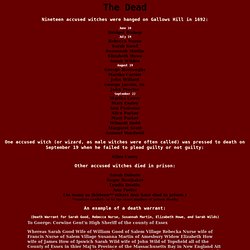

Convicted as Salem Witches. When hysteria mixed with family rivalries fomented the infamous Salem witch trials of 1692-93, more than 200 people were accused unjustly of practicing witchcraft.

Eventually, the colonial government acknowledged that the trials were a mistake, and compensated the families of those convicted. But that vindication came too late for the 19 defendants who were executed. A 20th, Giles Corey, was pressed to death when he refused to plead. As many as 13 others died in prison. Below are brief biographies of the executed. Bridget BishopAn older woman, Bishop had a reputation for gossiping and promiscuity, but when it came to witchcraft, she insisted to her judicial accusers that “I have no familiarity with the devil.” Sara GoodAfter her first marriage to an indentured servant left her deep in debt, Good married a laborer who worked in exchange for food and lodging, and the two eked out a meager existence in Salem Village.
Rev. Salem Witch Trials. A Brief History of the Salem Witch Trials. Salem Witch Trials — History.com Video. Witch hunting. Intro There was much superstition and ignorance in 17th century England.

Witchcraft had been illegal since 1563 and hundreds of women were wrongly accused and punished. 'Proof' of being a witch could be a third nipple, an unusual scar or birthmark, a boil, a growth, or even owning a cat or other pet (a 'witch's familiar', or evil spirit). Confessions were often made under torture, and suspects were tied up and thrown into a river or pond. Floating was proof of guilt. Professionals who exposed witches could make a lot of money, as local magistrates paid the witch finder the equivalent of a month's wages. Shelfmark: E.388.(2) Puritan Wife Swap. Salem Witch Trials History Ch. Salem Witchcraft: the Events and Causes of the Salem Witch Trials. By Tim Sutter © 2000-2003 What caused the Salem witch trials of 1692?

This question has been asked for over 300 years. Although it is a simple question, it does not have an easy answer. The answer is difficult because there are numerous factors and events that helped create and influence the trials. Salem Witch Trials Documentary Archive. Video Quest & Answers. Salem Video. Interactive Salem YOU! FAQs. How was the practice of witchcraft viewed in 17th century New England?

Under British law, the basis for Massachusetts Bay Colony legal structure in the 17th century, those who were accused of consorting with the devil were considered felons, having committed a crime against their government. The punishment for such a crime was hanging. What was the difference between the "afflicted" and the "accused"? The "afflicted" were those supposedly "possessed" and "tormented"; it was they who accused or "cried out" the names of those who were supposedly possessing them.
What caused the girls' behavior? This is a complex question. What role did Tituba play in the Salem witch trials? Tituba, an Arawak or Carib Indian from Barbados, was Reverend Samuel Parris' slave. Were only women accused of practicing witchcraft? Actually, men were accused as well. Deaths. The Dead Nineteen accused witches were hanged on Gallows Hill in 1692: June 10Bridget BishopJuly 19Rebecca NurseSarah GoodSusannah MartinElizabeth HoweSarah WildesAugust 19George BurroughsMartha CarrierJohn WillardGeorge Jacobs, Sr.John ProctorSeptember 22Martha CoreyMary EasteyAnn PudeatorAlice ParkerMary ParkerWilmott ReddMargaret ScottSamuel Wardwell One accused witch (or wizard, as male witches were often called) was pressed to death on September 19 when he failed to plead guilty or not guilty: Giles Corey Other accused witches died in prison: Sarah OsbornRoger ToothakerLyndia DustinAnn Foster(As many as thirteen** others may have died in prison.)

An example of a death warrant: (Death Warrant for Sarah Good, Rebecca Nurse, Susannah Martin, Elizabeth Howe, and Sarah Wilds) Chronology Salem. Biographies. The Salem Witch Trials, 1692. The Salem Witch Trials, 1692 The seeds of the hysteria that afflicted Salem Village, Massachusetts were sown in January 1692 when a group of young girls began to display bizarre behavior.

The tight-knit community was at a loss to explain the convulsive seizures, blasphemous screaming, and trance-like states that afflicted the youngsters. The physicians called in to examine the girls could find no natural cause of the disturbing behavior. If the source of the affliction was not attributable to a physical malady, the community reasoned that it must be the work of Satan. Witches had invaded Salem. In February the village began praying and fasting in order to rid itself of the devil's influence. Salem Witch Museum - Education - Salem, Massachusetts. In January of 1692, the daughter and niece of Reverend Samuel Parris of Salem Village became ill.

When they failed to improve, the village doctor, William Griggs, was called in. His diagnosis of bewitchment put into motion the forces that would ultimately result in the death by hanging of nineteen men and women. In addition, one man was crushed to death; seven others died in prison, and the lives of many were irrevocably changed. The Salem Witchcraft Trials of 1692.